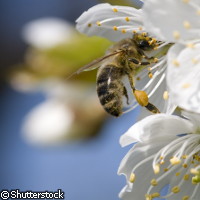Bees rely on sticky substance during their nectar jaunts
How do bumblebees collect nectar without losing their balance? New research from Britain's University of Cambridge has shown that 'Velcro'-like cells on petals help bees stick to flowers. Just as surprising is their finding that bees use touch to recognise the texture of petal surfaces. The study is published in the journal Current Biology. According to the researchers, led by Dr Beverley Glover from the Department of Plant Sciences at the University of Cambridge, bees select petals with conical cells, not flat or smooth surfaces, giving them the edge they need to get the job done. In the natural world, they said, bees take either visual or olfactory cues without needing to land on the flower itself. The scientists questioned whether the conical cells play a different role by providing a better grip on a slippery plant surface. 'The plant surface is by default flat, and development away from this default is thought to have some function of evolutionary advantage,' the study reads. Artificial flowers cast from epoxy resin were used in the experiment. Half of these flowers had conical cells, while the remaining ones had flat surfaces. The researchers found the bees did not prefer one over the other when the casts were in a horizontal position; the number of visits was split equally between the two flowers. However, as the angle of the cast increased, so did the bees' preference for the conical cells. The bees also selected the conical celled casts more than 60% of the time when the casts were vertical. 'Foraging bumblebees are able to discriminate between different surfaces via tactile cues alone,' the researchers explained. 'We find that bumblebees use colour cues to discriminate against flowers that lack conical cells - but only when flower surfaces are presented at steep angles, making them difficult to manipulate. This facilitation of physical handling is a likely explanation for the prevalence of conical epidermal petal cells in most flowering plants.' The team successfully visualised why the bees opted for the conical cells. Thanks to high-speed video photography, the researchers were able to see that the bees always got a good grip on the conical-cell casts, while they scrambled for a better grip on the smoother surface. Also, once on the conical cells, the bees were able to stop beating their wings and collect nectar. The researchers then examined whether bees in the natural world actually prefer real flowers with conical cells. Conical-celled snapdragon plants were compared with mutant snapdragons that have smooth surfaces. They found that when the flowers were horizontal and required little handling, the bees made equal visits to both flower types. But when the flowers were vertical and required complex handling, the visits to the snapdragons increased to 74%. Experts say some 80% of flowers have conical cells. The researchers of this study believe that all pollinators (insects that carry pollen from one flower to another) prefer to land on flowers with conical cells. 'For bees to maintain their balance and hold onto a flower is no easy task, especially in windy or wet conditions,' explained Dr Glover. 'It's great to see that evolution has come up with the simple solution of equipping flowers with a Velcro-like surface that bees can get a grip on.'
Countries
United Kingdom



